Attached files
| file | filename |
|---|---|
| EX-99.1 - EXHIBIT 99.1 - Booz Allen Hamilton Holding Corp | a1qfy21earningsreleasefi.htm |
| 8-K - 8-K - Booz Allen Hamilton Holding Corp | fy2021q18kearningsrele.htm |
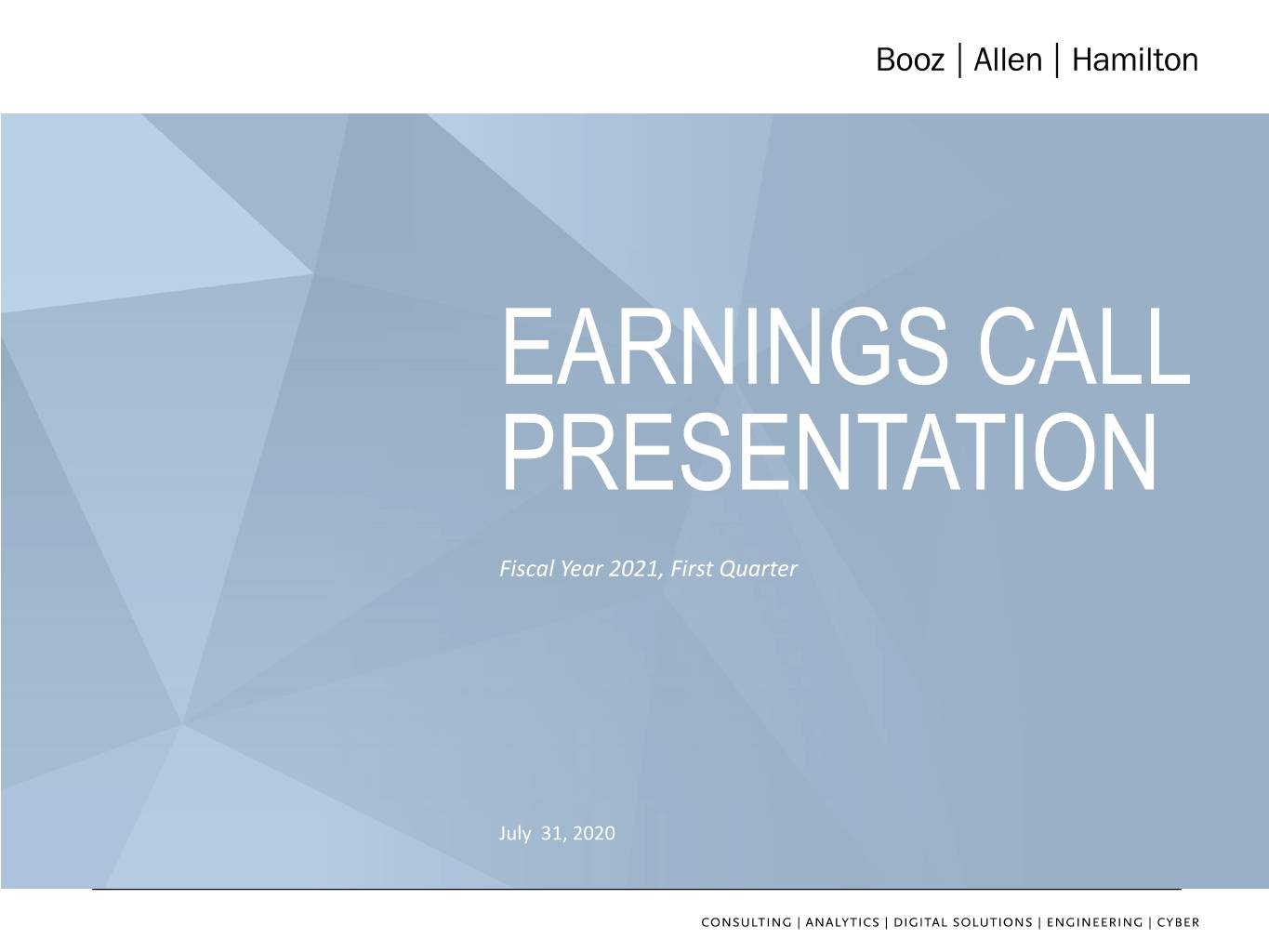
EARNINGS CALL PRESENTATION Fiscal Year 2021, First Quarter July 31, 2020

HORACIO ROZANSKI CALL President and Chief Executive Officer PARTICIPANTS LLOYD HOWELL, JR. Chief Financial Officer and Treasurer 2
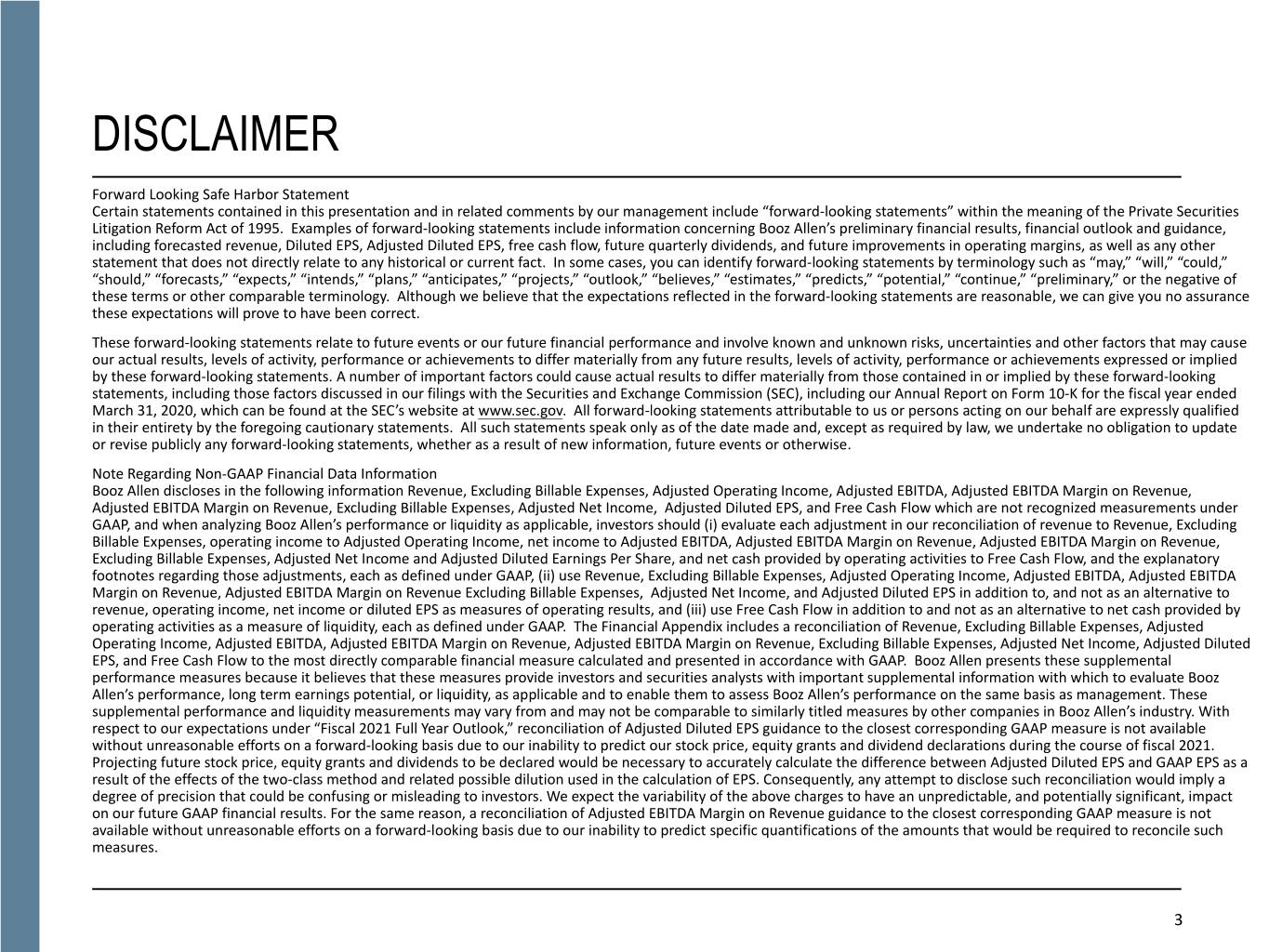
DISCLAIMER Forward Looking Safe Harbor Statement Certain statements contained in this presentation and in related comments by our management include “forward-looking statements” within the meaning of the Private Securities Litigation Reform Act of 1995. Examples of forward-looking statements include information concerning Booz Allen’s preliminary financial results, financial outlook and guidance, including forecasted revenue, Diluted EPS, Adjusted Diluted EPS, free cash flow, future quarterly dividends, and future improvements in operating margins, as well as any other statement that does not directly relate to any historical or current fact. In some cases, you can identify forward-looking statements by terminology such as “may,” “will,” “could,” “should,” “forecasts,” “expects,” “intends,” “plans,” “anticipates,” “projects,” “outlook,” “believes,” “estimates,” “predicts,” “potential,” “continue,” “preliminary,” or the negative of these terms or other comparable terminology. Although we believe that the expectations reflected in the forward-looking statements are reasonable, we can give you no assurance these expectations will prove to have been correct. These forward-looking statements relate to future events or our future financial performance and involve known and unknown risks, uncertainties and other factors that may cause our actual results, levels of activity, performance or achievements to differ materially from any future results, levels of activity, performance or achievements expressed or implied by these forward-looking statements. A number of important factors could cause actual results to differ materially from those contained in or implied by these forward-looking statements, including those factors discussed in our filings with the Securities and Exchange Commission (SEC), including our Annual Report on Form 10-K for the fiscal year ended March 31, 2020, which can be found at the SEC’s website at www.sec.gov. All forward-looking statements attributable to us or persons acting on our behalf are expressly qualified in their entirety by the foregoing cautionary statements. All such statements speak only as of the date made and, except as required by law, we undertake no obligation to update or revise publicly any forward-looking statements, whether as a result of new information, future events or otherwise. Note Regarding Non-GAAP Financial Data Information Booz Allen discloses in the following information Revenue, Excluding Billable Expenses, Adjusted Operating Income, Adjusted EBITDA, Adjusted EBITDA Margin on Revenue, Adjusted EBITDA Margin on Revenue, Excluding Billable Expenses, Adjusted Net Income, Adjusted Diluted EPS, and Free Cash Flow which are not recognized measurements under GAAP, and when analyzing Booz Allen’s performance or liquidity as applicable, investors should (i) evaluate each adjustment in our reconciliation of revenue to Revenue, Excluding Billable Expenses, operating income to Adjusted Operating Income, net income to Adjusted EBITDA, Adjusted EBITDA Margin on Revenue, Adjusted EBITDA Margin on Revenue, Excluding Billable Expenses, Adjusted Net Income and Adjusted Diluted Earnings Per Share, and net cash provided by operating activities to Free Cash Flow, and the explanatory footnotes regarding those adjustments, each as defined under GAAP, (ii) use Revenue, Excluding Billable Expenses, Adjusted Operating Income, Adjusted EBITDA, Adjusted EBITDA Margin on Revenue, Adjusted EBITDA Margin on Revenue Excluding Billable Expenses, Adjusted Net Income, and Adjusted Diluted EPS in addition to, and not as an alternative to revenue, operating income, net income or diluted EPS as measures of operating results, and (iii) use Free Cash Flow in addition to and not as an alternative to net cash provided by operating activities as a measure of liquidity, each as defined under GAAP. The Financial Appendix includes a reconciliation of Revenue, Excluding Billable Expenses, Adjusted Operating Income, Adjusted EBITDA, Adjusted EBITDA Margin on Revenue, Adjusted EBITDA Margin on Revenue, Excluding Billable Expenses, Adjusted Net Income, Adjusted Diluted EPS, and Free Cash Flow to the most directly comparable financial measure calculated and presented in accordance with GAAP. Booz Allen presents these supplemental performance measures because it believes that these measures provide investors and securities analysts with important supplemental information with which to evaluate Booz Allen’s performance, long term earnings potential, or liquidity, as applicable and to enable them to assess Booz Allen’s performance on the same basis as management. These supplemental performance and liquidity measurements may vary from and may not be comparable to similarly titled measures by other companies in Booz Allen’s industry. With respect to our expectations under “Fiscal 2021 Full Year Outlook,” reconciliation of Adjusted Diluted EPS guidance to the closest corresponding GAAP measure is not available without unreasonable efforts on a forward-looking basis due to our inability to predict our stock price, equity grants and dividend declarations during the course of fiscal 2021. Projecting future stock price, equity grants and dividends to be declared would be necessary to accurately calculate the difference between Adjusted Diluted EPS and GAAP EPS as a result of the effects of the two-class method and related possible dilution used in the calculation of EPS. Consequently, any attempt to disclose such reconciliation would imply a degree of precision that could be confusing or misleading to investors. We expect the variability of the above charges to have an unpredictable, and potentially significant, impact on our future GAAP financial results. For the same reason, a reconciliation of Adjusted EBITDA Margin on Revenue guidance to the closest corresponding GAAP measure is not available without unreasonable efforts on a forward-looking basis due to our inability to predict specific quantifications of the amounts that would be required to reconcile such measures. 3
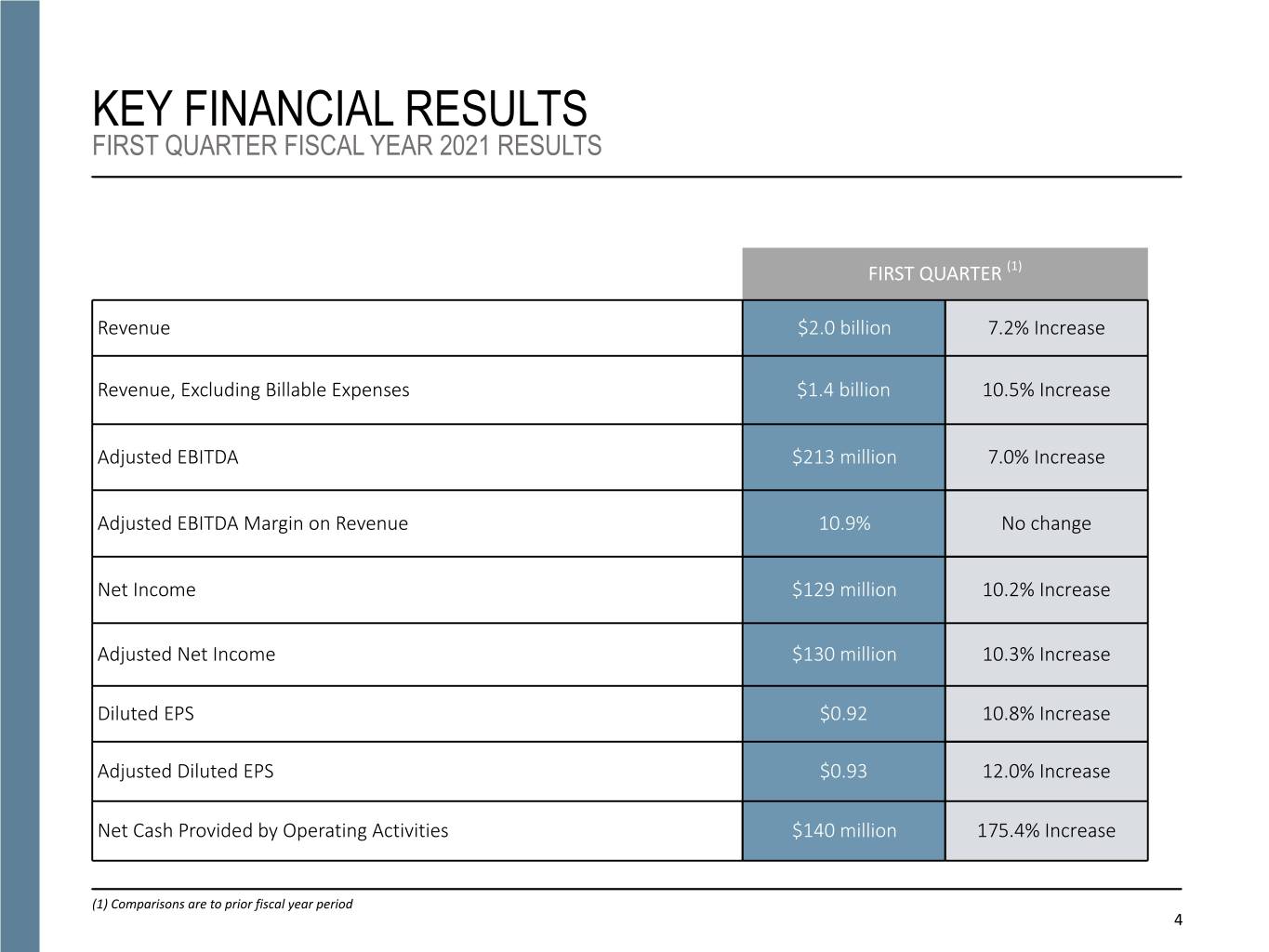
KEY FINANCIAL RESULTS FIRST QUARTER FISCAL YEAR 2021 RESULTS FIRST QUARTER (1) Revenue $2.0 billion 7.2% Increase Revenue, Excluding Billable Expenses $1.4 billion 10.5% Increase Adjusted EBITDA $213 million 7.0% Increase Adjusted EBITDA Margin on Revenue 10.9% No change Net Income $129 million 10.2% Increase Adjusted Net Income $130 million 10.3% Increase Diluted EPS $0.92 10.8% Increase Adjusted Diluted EPS $0.93 12.0% Increase Net Cash Provided by Operating Activities $140 million 175.4% Increase (1) Comparisons are to prior fiscal year period 4
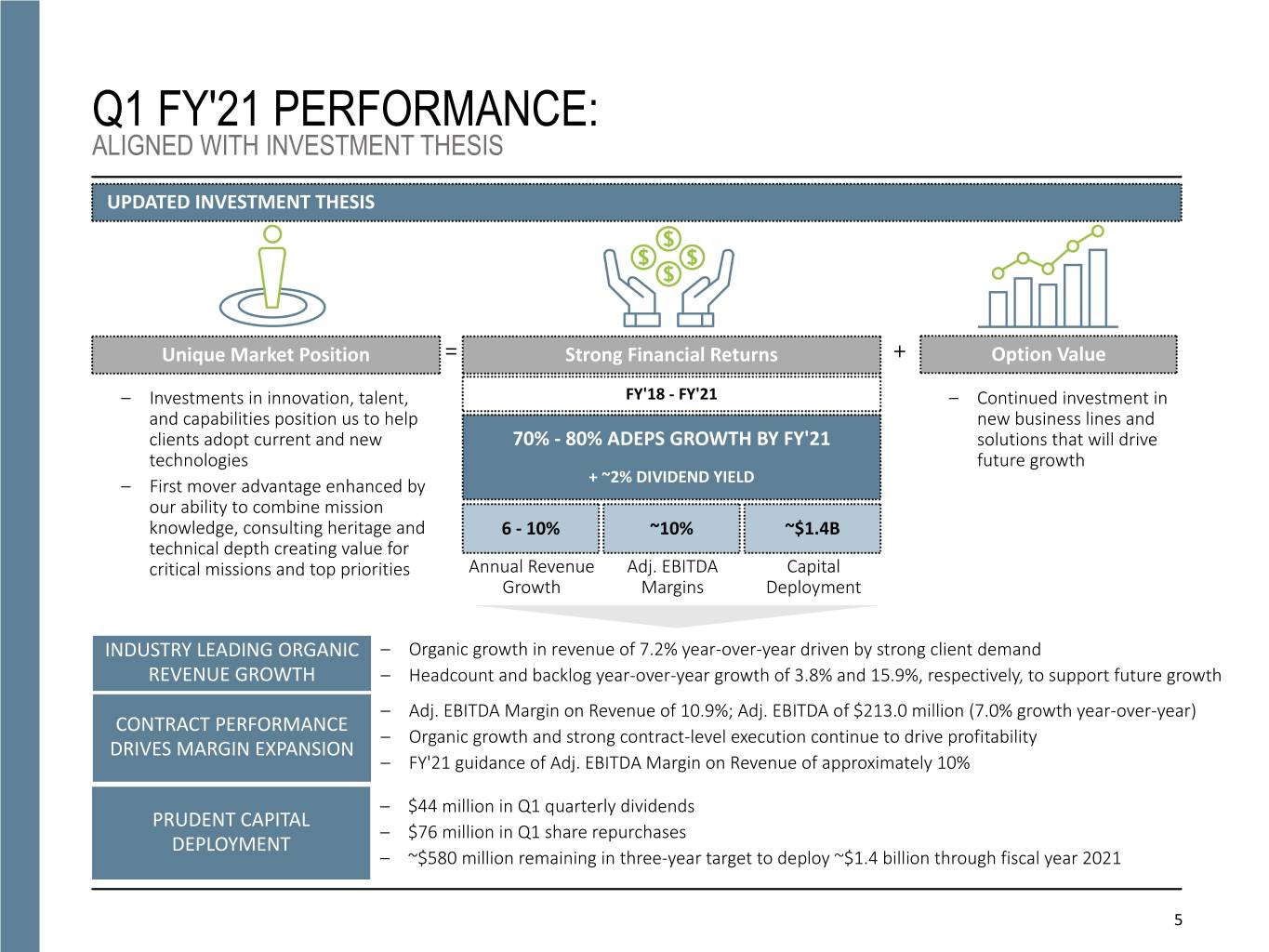
Q1 FY'21 PERFORMANCE: ALIGNED WITH INVESTMENT THESIS UPDATED INVESTMENT THESIS Unique Market Position = Strong Financial Returns + Option Value – Investments in innovation, talent, FY'18 - FY'21 – Continued investment in and capabilities position us to help new business lines and clients adopt current and new 70% - 80% ADEPS GROWTH BY FY'21 solutions that will drive technologies future growth – First mover advantage enhanced by + ~2% DIVIDEND YIELD our ability to combine mission knowledge, consulting heritage and 6 - 10% ~10% ~$1.4B technical depth creating value for critical missions and top priorities Annual Revenue Adj. EBITDA Capital Growth Margins Deployment INDUSTRY LEADING ORGANIC – Organic growth in revenue of 7.2% year-over-year driven by strong client demand REVENUE GROWTH – Headcount and backlog year-over-year growth of 3.8% and 15.9%, respectively, to support future growth – Adj. EBITDA Margin on Revenue of 10.9%; Adj. EBITDA of $213.0 million (7.0% growth year-over-year) CONTRACT PERFORMANCE – Organic growth and strong contract-level execution continue to drive profitability DRIVES MARGIN EXPANSION – FY'21 guidance of Adj. EBITDA Margin on Revenue of approximately 10% – $44 million in Q1 quarterly dividends PRUDENT CAPITAL – $76 million in Q1 share repurchases DEPLOYMENT – ~$580 million remaining in three-year target to deploy ~$1.4 billion through fiscal year 2021 5
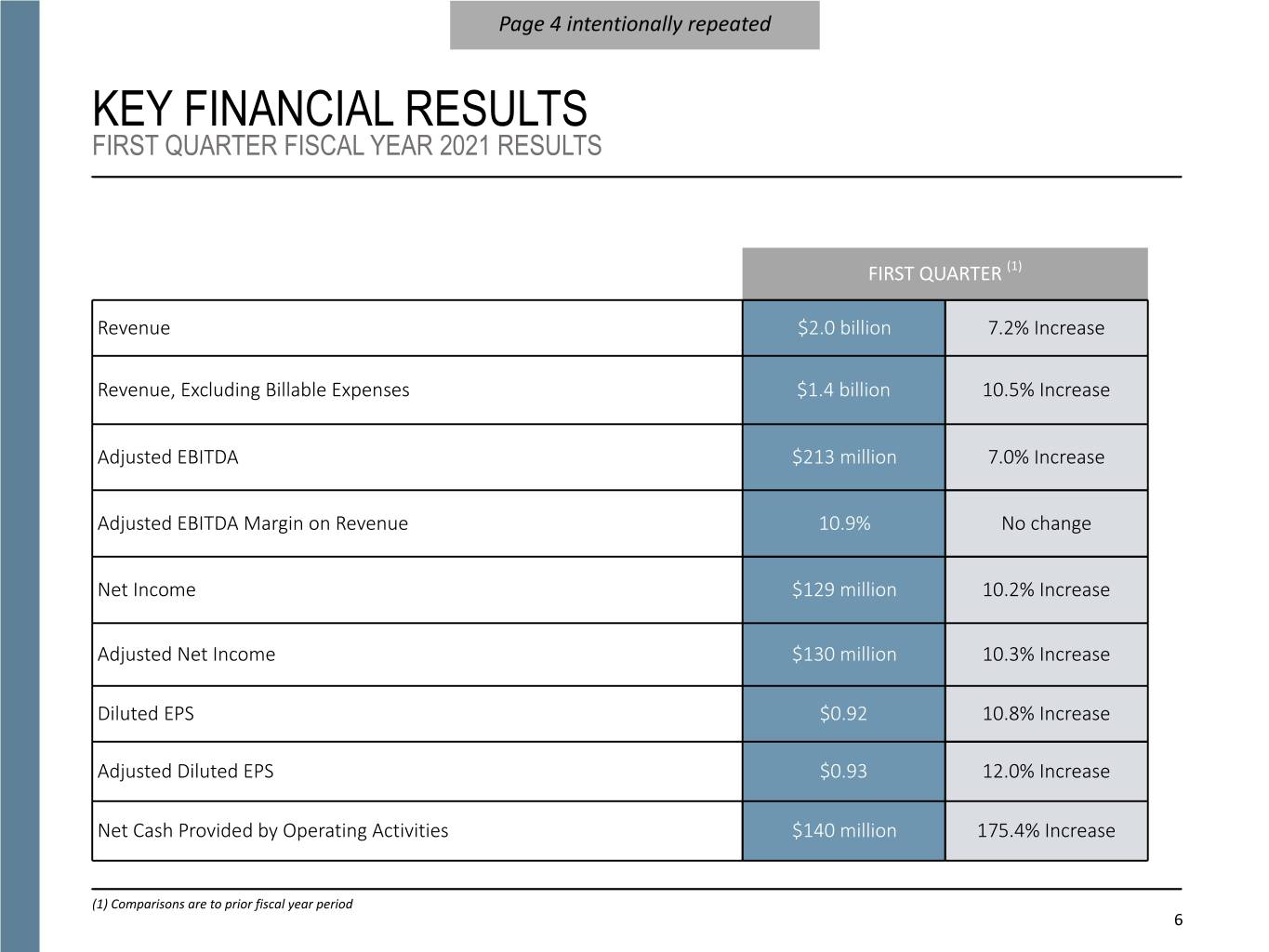
Page 4 intentionally repeated KEY FINANCIAL RESULTS FIRST QUARTER FISCAL YEAR 2021 RESULTS FIRST QUARTER (1) Revenue $2.0 billion 7.2% Increase Revenue, Excluding Billable Expenses $1.4 billion 10.5% Increase Adjusted EBITDA $213 million 7.0% Increase Adjusted EBITDA Margin on Revenue 10.9% No change Net Income $129 million 10.2% Increase Adjusted Net Income $130 million 10.3% Increase Diluted EPS $0.92 10.8% Increase Adjusted Diluted EPS $0.93 12.0% Increase Net Cash Provided by Operating Activities $140 million 175.4% Increase (1) Comparisons are to prior fiscal year period 6
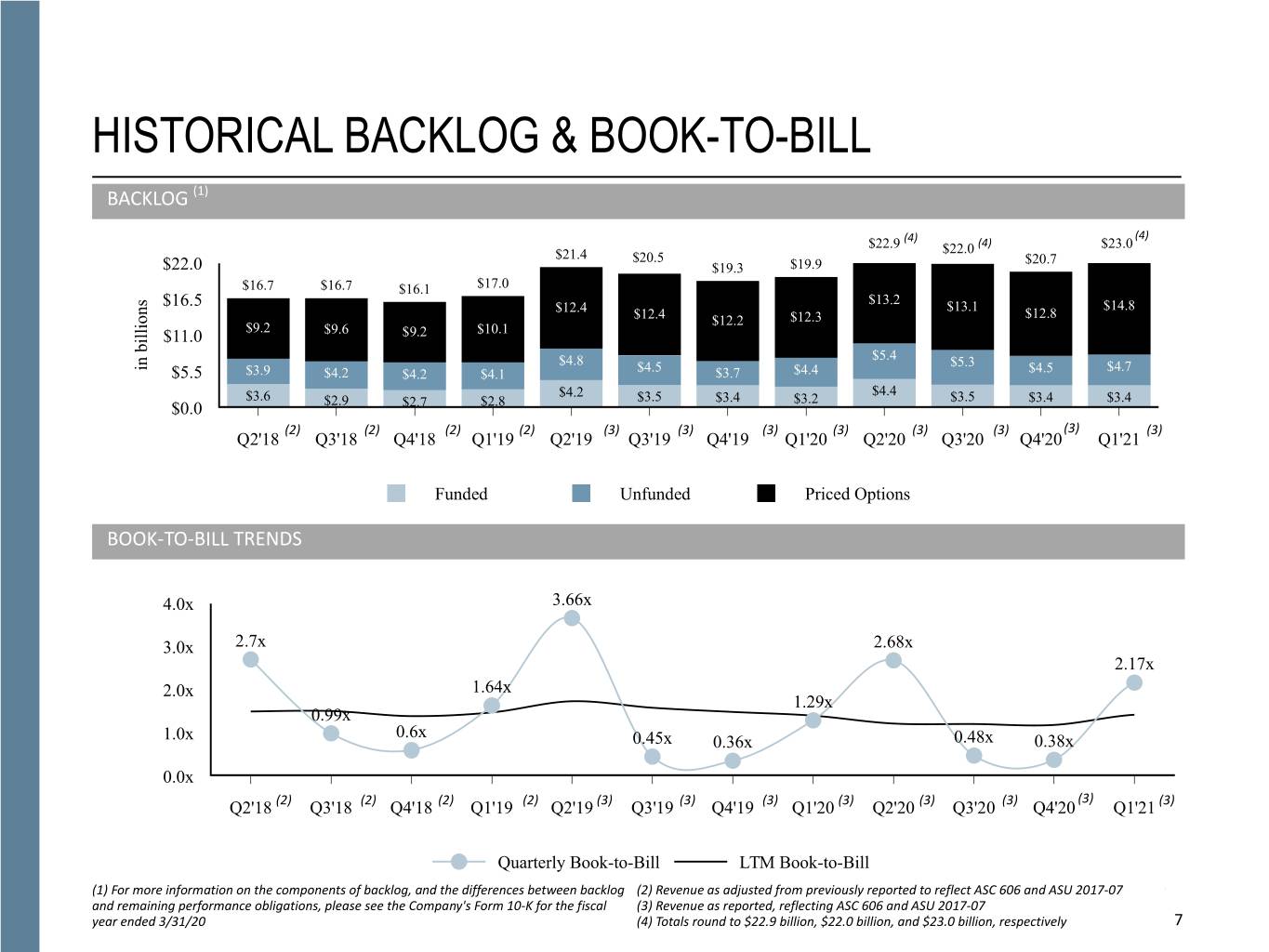
HISTORICAL BACKLOG & BOOK-TO-BILL BACKLOG (1) (4) $22.9$23.0 (4) (4) $23.0 $22.0$21.9 $22.9 $21.4 $20.5$20.4 $20.7 $22.0 $19.3 $19.9 $16.7 $16.7 $16.1 $17.0 s $13.2 $16.5 $12.4 $13.1 $14.8 n $12.4 $12.8 o $12.2 $12.3 i l $9.2 $9.6 $10.1 l $9.2 i $11.0 b $5.4 n $4.8 $5.3 i $4.5 $4.7 $5.5 $3.9 $4.2 $4.2 $4.1 $3.7 $4.4 $4.5 $4.4 $3.6 $4.2 $3.5 $3.4 $3.2 $3.5 $3.4 $3.4 $0.0 $2.9 $2.7 $2.8 (2) (2) (2) (2) (3) (3) (3) (3) (3) (3) (3) (3) Q2'18 Q3'18 Q4'18 Q1'19 Q2'19 Q3'19 Q4'19 Q1'20 Q2'20 Q3'20 Q4'20 Q1'21 Funded Unfunded Priced Options BOOK-TO-BILL TRENDS 4.0x 3.66x 3.0x 2.7x 2.68x 2.17x 2.0x 1.64x 1.29x 0.99x 0.6x 1.0x 0.45x 0.36x 0.48x 0.38x 0.0x (3) Q2'18 (2) Q3'18 (2) Q4'18 (2) Q1'19 (2) Q2'19 (3) Q3'19 (3) Q4'19 (3) Q1'20 (3) Q2'20 (3) Q3'20 (3) Q4'20 Q1'21 (3) Quarterly Book-to-Bill LTM Book-to-Bill (1) For more information on the components of backlog, and the differences between backlog (2) Revenue as adjusted from previously reported to reflect ASC 606 and ASU 2017-07 and remaining performance obligations, please see the Company's Form 10-K for the fiscal (3) Revenue as reported, reflecting ASC 606 and ASU 2017-07 year ended 3/31/20 (4) Totals round to $22.9 billion, $22.0 billion, and $23.0 billion, respectively 7
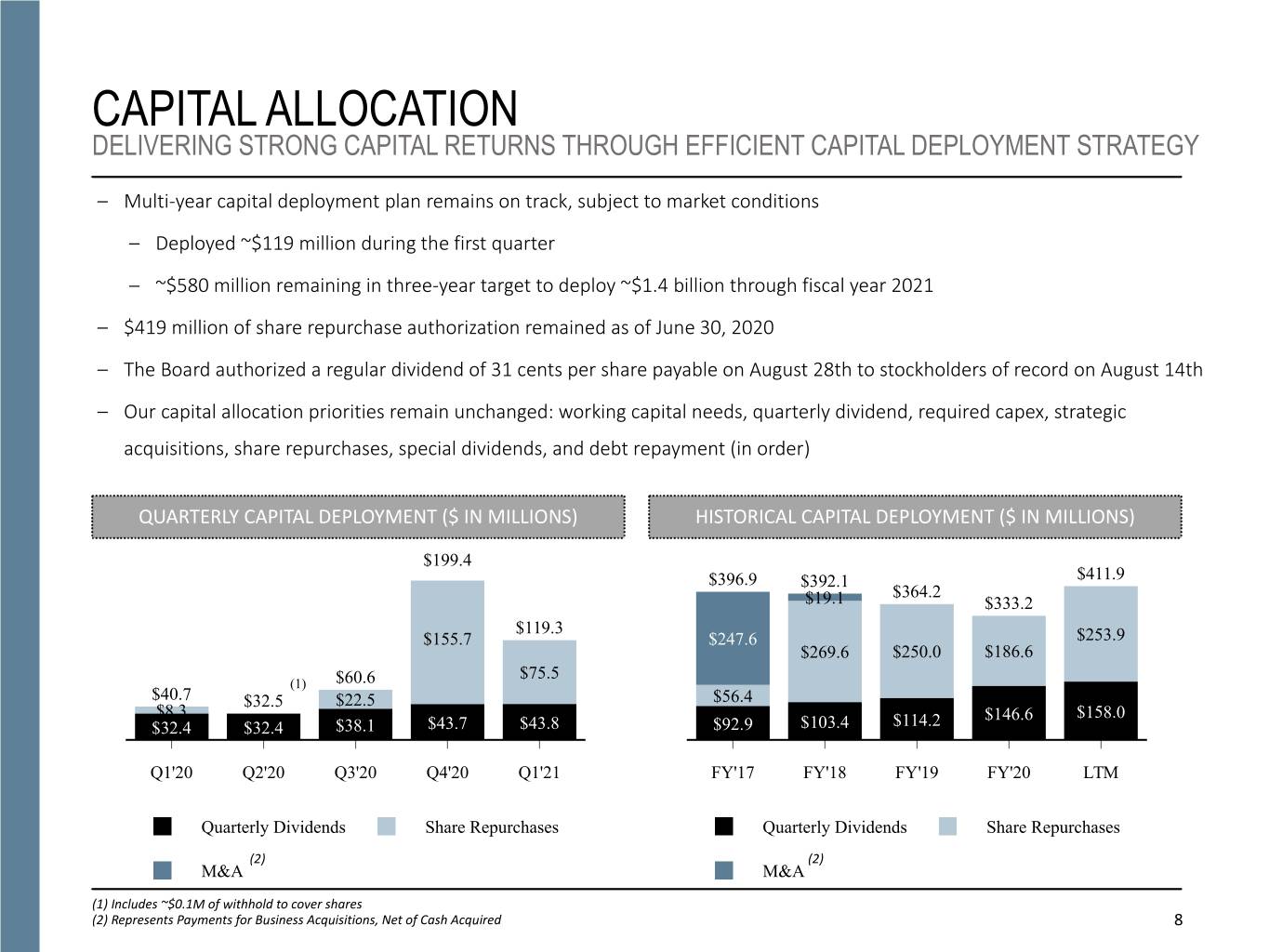
CAPITAL ALLOCATION DELIVERING STRONG CAPITAL RETURNS THROUGH EFFICIENT CAPITAL DEPLOYMENT STRATEGY – Multi-year capital deployment plan remains on track, subject to market conditions – Deployed ~$119 million during the first quarter – ~$580 million remaining in three-year target to deploy ~$1.4 billion through fiscal year 2021 – $419 million of share repurchase authorization remained as of June 30, 2020 – The Board authorized a regular dividend of 31 cents per share payable on August 28th to stockholders of record on August 14th – Our capital allocation priorities remain unchanged: working capital needs, quarterly dividend, required capex, strategic acquisitions, share repurchases, special dividends, and debt repayment (in order) QUARTERLY CAPITAL DEPLOYMENT ($ IN MILLIONS) HISTORICAL CAPITAL DEPLOYMENT ($ IN MILLIONS) $199.4 $396.9 $392.1 $411.9 $364.2 $19.1 $333.2 $119.3 $155.7 $247.6 $253.9 $269.6 $250.0 $186.6 $75.5 (1) $60.6 $40.7 $32.5 $22.5 $56.4 $8.3 $146.6 $158.0 $32.4 $32.4 $38.1 $43.7 $43.8 $92.9 $103.4 $114.2 Q1'20 Q2'20 Q3'20 Q4'20 Q1'21 FY'17 FY'18 FY'19 FY'20 LTM Quarterly Dividends Share Repurchases Quarterly Dividends Share Repurchases (2) (2) M&A Special Dividends M&A Special Dividends (1) Includes ~$0.1M of withhold to cover shares (2) Represents Payments for Business Acquisitions, Net of Cash Acquired 8
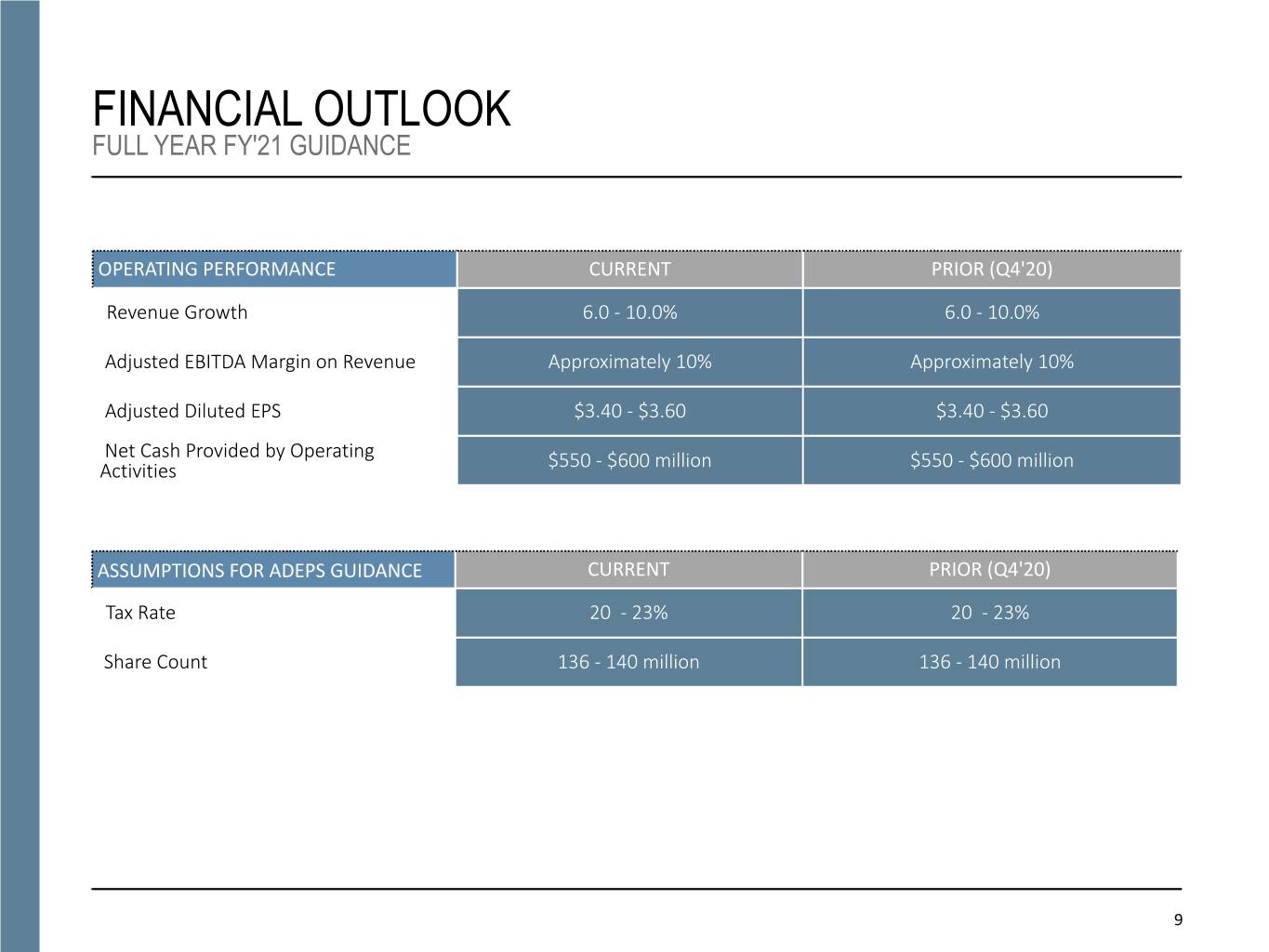
FINANCIAL OUTLOOK FULL YEAR FY'21 GUIDANCE OPERATING PERFORMANCE CURRENT PRIOR (Q4'20) Revenue Growth 6.0 - 10.0% 6.0 - 10.0% Adjusted EBITDA Margin on Revenue Approximately 10% Approximately 10% Adjusted Diluted EPS $3.40 - $3.60 $3.40 - $3.60 Net Cash Provided by Operating $550 - $600 million $550 - $600 million Activities ASSUMPTIONS FOR ADEPS GUIDANCE CURRENT PRIOR (Q4'20) Tax Rate 20 - 23% 20 - 23% Share Count 136 - 140 million 136 - 140 million 9

APPENDIX 10
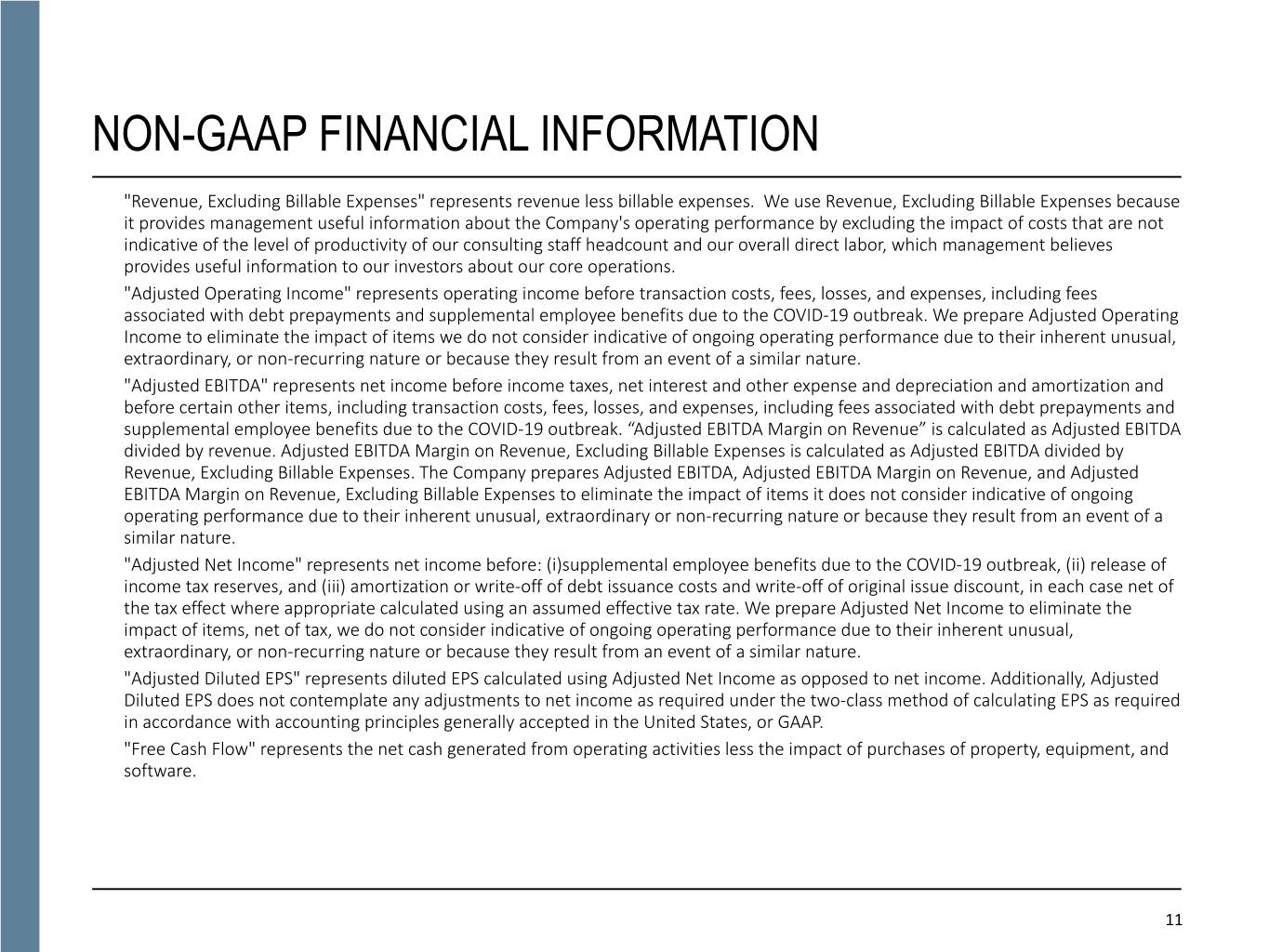
NON-GAAP FINANCIAL INFORMATION "Revenue, Excluding Billable Expenses" represents revenue less billable expenses. We use Revenue, Excluding Billable Expenses because it provides management useful information about the Company's operating performance by excluding the impact of costs that are not indicative of the level of productivity of our consulting staff headcount and our overall direct labor, which management believes provides useful information to our investors about our core operations. "Adjusted Operating Income" represents operating income before transaction costs, fees, losses, and expenses, including fees associated with debt prepayments and supplemental employee benefits due to the COVID-19 outbreak. We prepare Adjusted Operating Income to eliminate the impact of items we do not consider indicative of ongoing operating performance due to their inherent unusual, extraordinary, or non-recurring nature or because they result from an event of a similar nature. "Adjusted EBITDA" represents net income before income taxes, net interest and other expense and depreciation and amortization and before certain other items, including transaction costs, fees, losses, and expenses, including fees associated with debt prepayments and supplemental employee benefits due to the COVID-19 outbreak. “Adjusted EBITDA Margin on Revenue” is calculated as Adjusted EBITDA divided by revenue. Adjusted EBITDA Margin on Revenue, Excluding Billable Expenses is calculated as Adjusted EBITDA divided by Revenue, Excluding Billable Expenses. The Company prepares Adjusted EBITDA, Adjusted EBITDA Margin on Revenue, and Adjusted EBITDA Margin on Revenue, Excluding Billable Expenses to eliminate the impact of items it does not consider indicative of ongoing operating performance due to their inherent unusual, extraordinary or non-recurring nature or because they result from an event of a similar nature. "Adjusted Net Income" represents net income before: (i)supplemental employee benefits due to the COVID-19 outbreak, (ii) release of income tax reserves, and (iii) amortization or write-off of debt issuance costs and write-off of original issue discount, in each case net of the tax effect where appropriate calculated using an assumed effective tax rate. We prepare Adjusted Net Income to eliminate the impact of items, net of tax, we do not consider indicative of ongoing operating performance due to their inherent unusual, extraordinary, or non-recurring nature or because they result from an event of a similar nature. "Adjusted Diluted EPS" represents diluted EPS calculated using Adjusted Net Income as opposed to net income. Additionally, Adjusted Diluted EPS does not contemplate any adjustments to net income as required under the two-class method of calculating EPS as required in accordance with accounting principles generally accepted in the United States, or GAAP. "Free Cash Flow" represents the net cash generated from operating activities less the impact of purchases of property, equipment, and software. 11
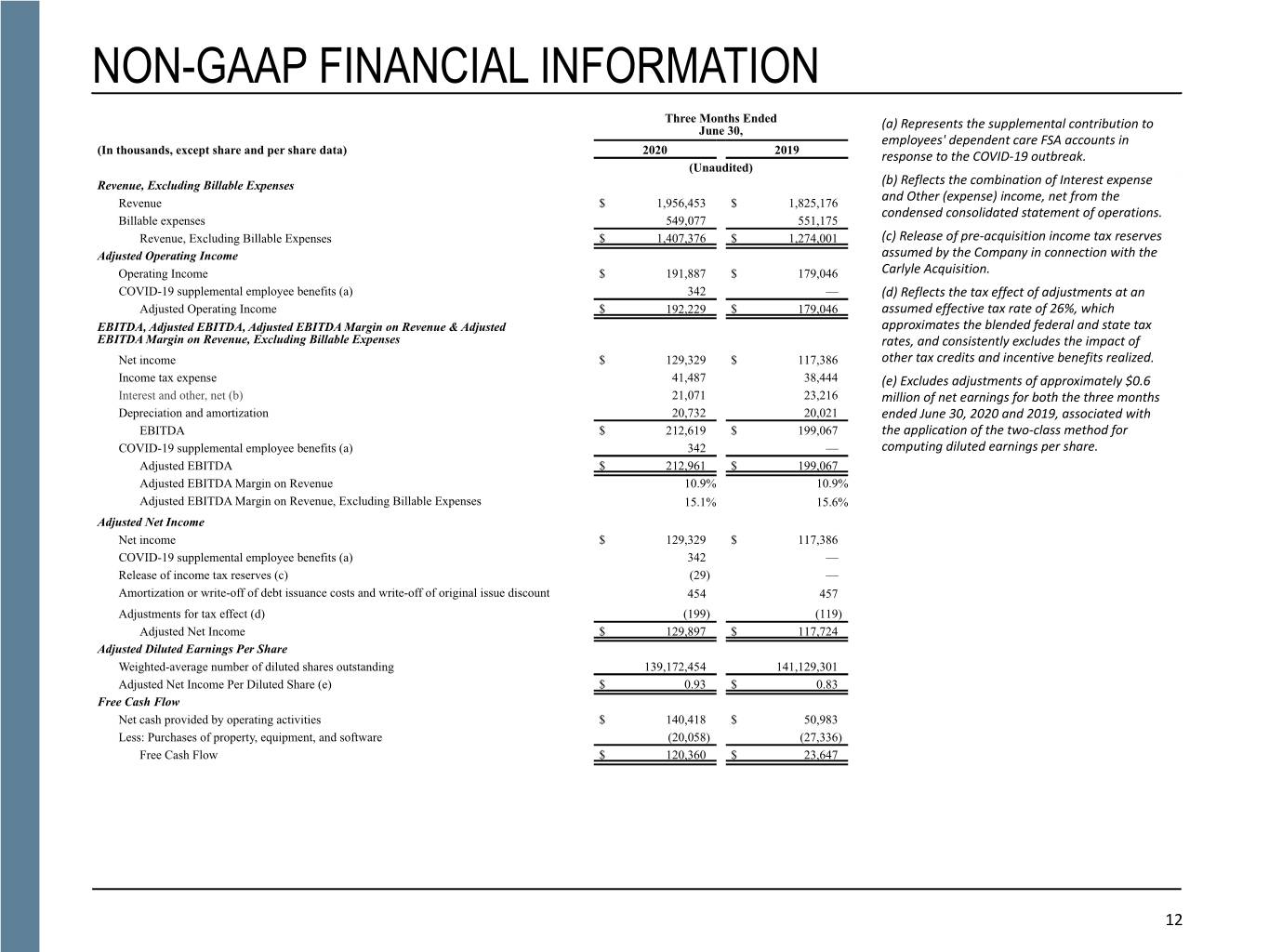
NON-GAAP FINANCIAL INFORMATION Three Months Ended June 30, (a) Represents the supplemental contribution to employees' dependent care FSA accounts in (In thousands, except share and per share data) 2020 2019 response to the COVID-19 outbreak. (Unaudited) Revenue, Excluding Billable Expenses (b) Reflects the combination of Interest expense Revenue $ 1,956,453 $ 1,825,176 and Other (expense) income, net from the condensed consolidated statement of operations. Billable expenses 549,077 551,175 Revenue, Excluding Billable Expenses $ 1,407,376 $ 1,274,001 (c) Release of pre-acquisition income tax reserves Adjusted Operating Income assumed by the Company in connection with the Operating Income $ 191,887 $ 179,046 Carlyle Acquisition. COVID-19 supplemental employee benefits (a) 342 — (d) Reflects the tax effect of adjustments at an Adjusted Operating Income $ 192,229 $ 179,046 assumed effective tax rate of 26%, which EBITDA, Adjusted EBITDA, Adjusted EBITDA Margin on Revenue & Adjusted approximates the blended federal and state tax EBITDA Margin on Revenue, Excluding Billable Expenses rates, and consistently excludes the impact of Net income $ 129,329 $ 117,386 other tax credits and incentive benefits realized. Income tax expense 41,487 38,444 (e) Excludes adjustments of approximately $0.6 Interest and other, net (b) 21,071 23,216 million of net earnings for both the three months Depreciation and amortization 20,732 20,021 ended June 30, 2020 and 2019, associated with EBITDA $ 212,619 $ 199,067 the application of the two-class method for COVID-19 supplemental employee benefits (a) 342 — computing diluted earnings per share. Adjusted EBITDA $ 212,961 $ 199,067 Adjusted EBITDA Margin on Revenue 10.9% 10.9% Adjusted EBITDA Margin on Revenue, Excluding Billable Expenses 15.1% 15.6% Adjusted Net Income Net income $ 129,329 $ 117,386 COVID-19 supplemental employee benefits (a) 342 — Release of income tax reserves (c) (29) — Amortization or write-off of debt issuance costs and write-off of original issue discount 454 457 Adjustments for tax effect (d) (199) (119) Adjusted Net Income $ 129,897 $ 117,724 Adjusted Diluted Earnings Per Share Weighted-average number of diluted shares outstanding 139,172,454 141,129,301 Adjusted Net Income Per Diluted Share (e) $ 0.93 $ 0.83 Free Cash Flow Net cash provided by operating activities $ 140,418 $ 50,983 Less: Purchases of property, equipment, and software (20,058) (27,336) Free Cash Flow $ 120,360 $ 23,647 12
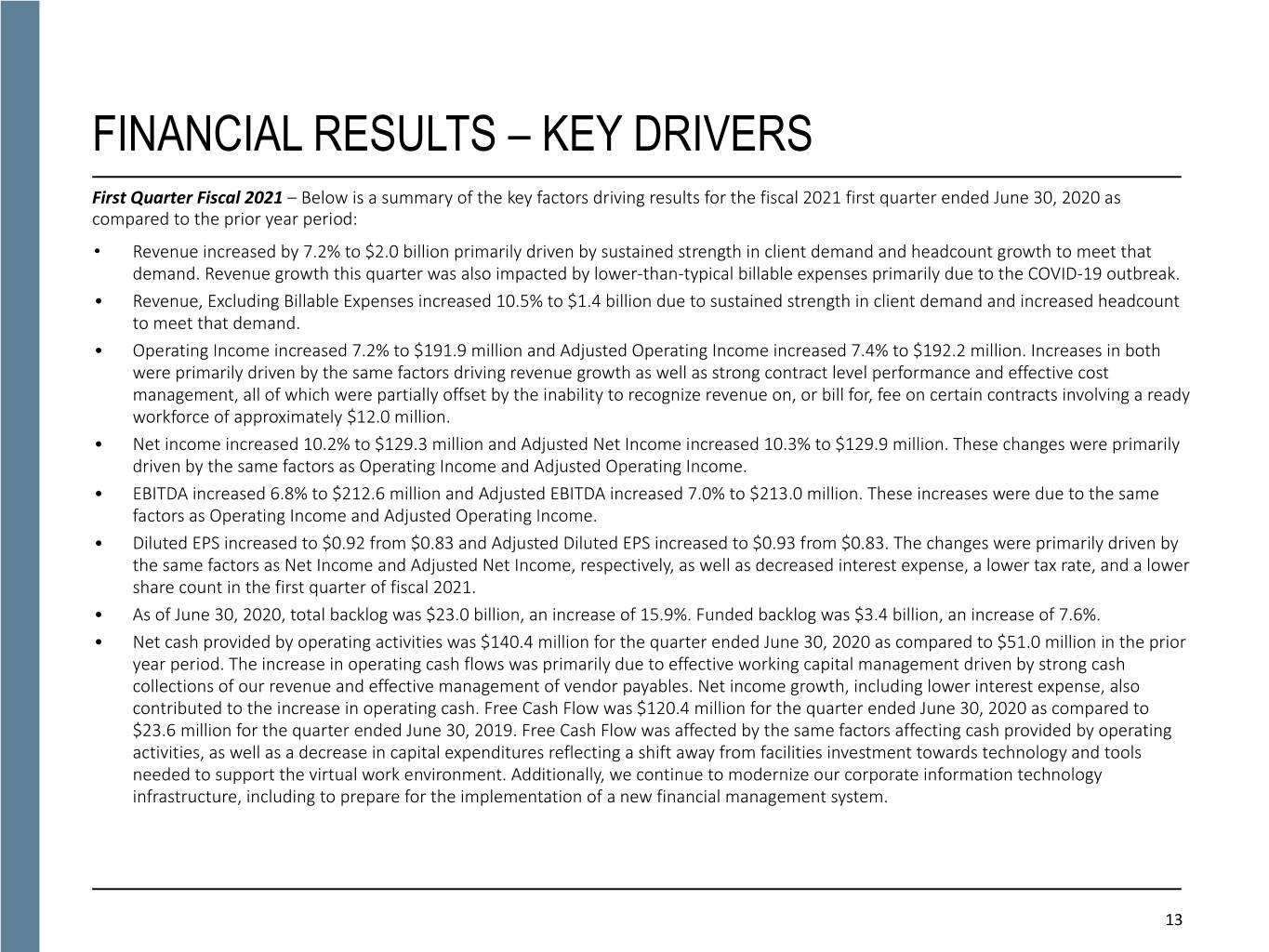
FINANCIAL RESULTS – KEY DRIVERS First Quarter Fiscal 2021 – Below is a summary of the key factors driving results for the fiscal 2021 first quarter ended June 30, 2020 as compared to the prior year period: • Revenue increased by 7.2% to $2.0 billion primarily driven by sustained strength in client demand and headcount growth to meet that demand. Revenue growth this quarter was also impacted by lower-than-typical billable expenses primarily due to the COVID-19 outbreak. • Revenue, Excluding Billable Expenses increased 10.5% to $1.4 billion due to sustained strength in client demand and increased headcount to meet that demand. • Operating Income increased 7.2% to $191.9 million and Adjusted Operating Income increased 7.4% to $192.2 million. Increases in both were primarily driven by the same factors driving revenue growth as well as strong contract level performance and effective cost management, all of which were partially offset by the inability to recognize revenue on, or bill for, fee on certain contracts involving a ready workforce of approximately $12.0 million. • Net income increased 10.2% to $129.3 million and Adjusted Net Income increased 10.3% to $129.9 million. These changes were primarily driven by the same factors as Operating Income and Adjusted Operating Income. • EBITDA increased 6.8% to $212.6 million and Adjusted EBITDA increased 7.0% to $213.0 million. These increases were due to the same factors as Operating Income and Adjusted Operating Income. • Diluted EPS increased to $0.92 from $0.83 and Adjusted Diluted EPS increased to $0.93 from $0.83. The changes were primarily driven by the same factors as Net Income and Adjusted Net Income, respectively, as well as decreased interest expense, a lower tax rate, and a lower share count in the first quarter of fiscal 2021. • As of June 30, 2020, total backlog was $23.0 billion, an increase of 15.9%. Funded backlog was $3.4 billion, an increase of 7.6%. • Net cash provided by operating activities was $140.4 million for the quarter ended June 30, 2020 as compared to $51.0 million in the prior year period. The increase in operating cash flows was primarily due to effective working capital management driven by strong cash collections of our revenue and effective management of vendor payables. Net income growth, including lower interest expense, also contributed to the increase in operating cash. Free Cash Flow was $120.4 million for the quarter ended June 30, 2020 as compared to $23.6 million for the quarter ended June 30, 2019. Free Cash Flow was affected by the same factors affecting cash provided by operating activities, as well as a decrease in capital expenditures reflecting a shift away from facilities investment towards technology and tools needed to support the virtual work environment. Additionally, we continue to modernize our corporate information technology infrastructure, including to prepare for the implementation of a new financial management system. 13
